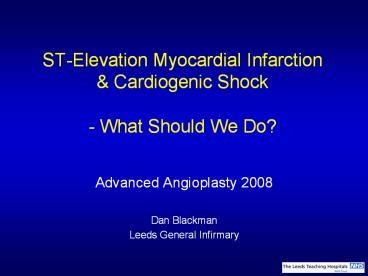ST-Elevation Myocardial Infarction - PowerPoint PPT Presentation
1 / 20
Title:
ST-Elevation Myocardial Infarction
Description:
St Jude. Travel/Sponsorship. Cordis. Boston Scientific. Medtronic. Abbott. St Jude. Causes of Cardiogenic Shock. Predominant LV Failure. 74.5% Acute Severe MR. 8.3 ... – PowerPoint PPT presentation
Number of Views:354
Avg rating:3.0/5.0
Title: ST-Elevation Myocardial Infarction
1
ST-Elevation Myocardial Infarction Cardiogenic
Shock- What Should We Do?
- Advanced Angioplasty 2008
- Dan Blackman
- Leeds General Infirmary
2
Conflicts of interest
- Advisory Boards
- Cordis
- Boston Scientific
- Medtronic
- Nycomed
- Lilly
- St Jude
- Travel/Sponsorship
- Cordis
- Boston Scientific
- Medtronic
- Abbott
- St Jude
3
Causes of Cardiogenic Shock
Tamponade/rupture 1.7
Other 7.5
Isolated RV Shock 3.4
VSD 4.6
Acute Severe MR 8.3
Predominant LV Failure 74.5
Shock Registry JACC 2000 351063
4
Survival from mechanical causes
Shock Registry JACC 2000361104 36 1110 GUSTO
1 Circulation 200010127 Holzer R CCI 200461196
5
Emergency revascularisation - SHOCK Trial
p0.03
p0.11
85 of survivors NYHA Class I/II at 12 months
Hochman JAMA 2000285190
6
Emergency revascularisation in the Elderly-
SHOCK Trial
p0.01
p0.01
- gt75 years ERV vs IMS baseline characteristics
- LVEF 28 vs 36 p0.051
- Anterior MI 63 vs 41 p0.18
- Female 54 vs 31 p0.11
7
Elderly - SHOCK other registry data
n44
n233
n61
n74
8
Single vessel or Multivessel PCI? - SHOCK Trial
- 81 of PCI patients multivessel disease
- 85 PCI IRA only 23 complete revascularisation
plt0.01
pNS
Shock Trial
Shock Registry
9
The panel believes that all accessible vessels
should be treated in patients with cardiogenic
shock
Current Recommendations- 1-2 vessel disease
PCI IRA 3VD PCI IRA staged complete
revascularisation Early MV PCI may be warranted
if shock persists despite IRA PCI
10
Is there a role for CABG SHOCK Data
pNS
n47
n81
n276
n109
- SHOCK Trial CABG vs PCI baseline characteristics
- LMS Disease 41 vs 13 p0.051
- 3VD 80 vs 60 p0.18
- Diabetes 49 vs 27 p0.11
11
Intra-aortic balloon pump counterpulsation
12
IABP in Cardiogenic Shock Primary PCI
Retrospective analysis of 23,180 patients from
NRMI database 7268 treated by IABP
13
Timing of IABP in Cardiogenic Shock Primary PCI
- Single centre registry Primary PCI for shock
Brodie AJC 19998418
14
Inotropes and Vasopressors
- No meaningful data!
- ACC/AHA Guidelines
- SBP lt70-
- Norepinephrine (0.5-30 ?g/min)
- Switch to Dopamine (5-15 ?g/kg/min) once SBP 80
- SBP 70-100
- Dopamine (5-15 ?g/kg/min)
- Add dobutamine (2-20 ?g/kg/min) once SBP 90
15
Percutaneous left ventricular assist devices
- Even with revascularisation and IABP support
mortality from cardiogenic shock post STEMI
remains 50 - Recovery of myocardial performance following
successful revascularisation may take several
days. During this time many patients succumb to
low cardiac output - If effective, active cardiac support could be
provided while awaiting the beneficial effects of
revascularisation, survival rates may be enhanced
16
Tandem Heart pLVAD
- Left atrial-to-femoral arterial LVAD
- Low speed centrifugal continuous flow pump
- 21F venous transeptal cannula
- 17F arterial cannula
- Maximum flow 4L/minute
- Cost 7.5K
17
Tandem Heart Outcome Data
pNS
Improved haemodynamic parameters Increase in
bleeding, limb ischaemia, and sepsis
Thiele EHJ 2005261276. Burkhoff AHJ 2006152e1
18
Impella
- Axial flow pump
- Much simpler to use
- Increases cardiac output unloads LV
- LP 2.5
- 12 F percutaneous approach Maximum 2.5 L flow
- LP 5.0
- 21 F surgical cutdown Maximum 5L flow
- Cost 3-5K
Blood Inlet
Blood outlet
Motor
Pressure Lumen
19
Impella outcome data
- 1 RCT of Impella 2.5 in AMI Cardiogenic Shock
- ISAR-SHOCK
- 26 patient RCT Impella vs IABP
- ? Cardiac Index, ? MAP (by 10mmHg) vs IABP
- Complications IABP
- No difference in mortality
20
What we should do about STEMI Cardiogenic Shock
- Emergency angiography and revascularisation
Primary PCI preferably - All patients lt75 years
- Selected patients 75 years
- On-table echo to rule out mechanical defects
- Stabilise the patient in the lab before
revascularisation - IABP
- Pressors if required (Norepinephrine/dopamine)
- Anaesthetic support
- Consider calling the surgeon for true surgical
disease - PCI culprit artery. Other vessels if shock
persists - Use abciximab for PCI
- Consider percutaneous LVAD if shock persists with
IABP multi-vessel revascularisation































